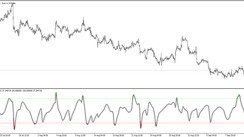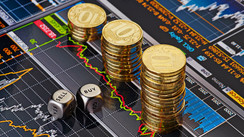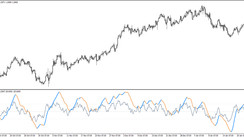Monday witnessed a retreat in the dollar from a five-week peak, provoked by a disappointing manufacturing index in New York and the need for a consolidation of the gains made the previous week due to anxieties over the U.S. debt ceiling and the country's economic health.
In the sphere of emerging markets, the Turkish lira suffered, approaching a record low as election results hinted at a probable runoff. In contrast, the Thai baht witnessed a surge, buoyed by a decisive election outcome.
The dollar slips
An early stumble for the greenback was prompted by statistics revealing a dramatic drop in the Empire State manufacturing index of the New York Federal Reserve, plummeting to -31.8 in May from a 10.8 score in April.
Action Economics highlighted in a recent blog post that this drastic fall in the Empire State index was the most significant drop since April of the previous year, hitting the lowest point since a three-year low of -32.9 in January.
This decrease in the dollar's value followed a stellar performance the previous week, marking its best weekly progress since September of the previous year.
Marc Chandler, the chief market strategist at Bannockburn Global Forex in New York, remarked, "I believe we're merely experiencing a period of consolidation today after the dollar's significant surge last week."
He further added, "The issues that have been dragging the dollar down, such as the debt ceiling, persist, despite some recent advancements."
Biden's Agenda: A Crucial Meeting and the Debt Ceiling
On Tuesday, President Joe Biden is expected to have direct discussions with congressional leaders, a day before departing for a Group of Seven nations meeting in Japan.
Despite the apparent lack of consensus between the two factions, the White House has yet to dismiss the annual spending limits that Republicans insist must accompany any expansion of the country's $31.4 trillion debt limit.
Late in the morning trading session, the dollar index, which evaluates the value of the greenback against six principal counterparts, slid 0.2% to 102.48. Earlier in the session, it had briefly reached a five-week apex of 102.75.
Several factors may have contributed to the recent surge in the dollar, including U.S. inflation worries, safe-haven purchasing triggered by apprehension about the debt ceiling stalemate, and fears about global economic expansion.
Alvin Tan, RBC Capital Markets' head of Asia FX strategy, suggested that the recent increase in U.S. bond yields could be bolstering the currency.
U.S. yields experienced a rise on both Friday and Monday after a University of Michigan consumer survey revealed that long-term inflation expectations had soared to a peak not seen since 2011.
This development has reintroduced the possibility of a Federal Reserve rate increase next month, with market participants currently predicting a 17% probability.
The euro experienced a 0.2% increase against the dollar, trading at $1.0875, bouncing back after a 1.54% decrease the prior week.
The dollar increased 0.3% against the yen, trading at 136.14, while the sterling saw a 0.5% rise, trading at $1.2513, recovering from a 1.45% slump the previous week.
In other developments, the dollar was trading 0.5% higher at 19.67 Turkish lira, having earlier surged to 19.7 for the first time since March 10 when it reached a record high of 19.8 on a particularly unstable trading day
Simultaneously, the dollar faced a 0.5% setback against the Thai baht, settling at 33.81 in onshore trading. This follows a surprise election victory by Thailand's opposition parties over the past weekend.
In a complex and rapidly changing global economic landscape, the U.S. dollar, as a key player, inevitably mirrors these fluctuations. Various factors, such as domestic fiscal policy, geopolitical tensions, and market sentiments, are in constant play, adding to the intricate dynamics that govern the dollar's value.
The recent concerns about the U.S. debt ceiling and the country's overall economic stability have undeniably exerted pressure on the greenback. However, the currency has proven its resilience in the past and continues to be a vital cog in the global economic machine. It remains to be seen how these ongoing concerns will unfold and how they will influence the dollar's trajectory moving forward.
The potential impact of President Biden's upcoming meetings with congressional leaders and his subsequent participation in the Group of Seven nations assembly in Japan could also introduce new dynamics to the situation. As the debt ceiling debate continues, all eyes will be on the White House and how its stance might affect the U.S. and global economy.
In conclusion, the dollar's recent performance against various currencies highlights the shifting nature of the global market. It's a clear reminder that while the economic landscape may be peppered with uncertainties and challenges, opportunities for growth and change remain abundant. As we navigate these tumultuous financial seas, we can only speculate on what lies ahead for the dollar and the global economy.
In the global economic playground, the U.S. dollar stands as a significant player whose performance often reflects the world's economic health. Monday brought about a decline in the dollar from a five-week pinnacle, primarily influenced by a disappointing manufacturing index in New York and the necessary consolidation of last week's gains. These gains were fueled by anxieties revolving around the U.S. debt ceiling and the general economic stability of the country.
Focusing on emerging markets, the Turkish lira was thrust into an uncomfortable position, teetering on the brink of a record low as election results hinted at a potential runoff. This contrasted starkly with the Thai baht's experience, which enjoyed an upward thrust following a clear-cut election outcome.
The greenback faced an early setback catalyzed by alarming data. The Empire State manufacturing index of the New York Federal Reserve plunged dramatically to -31.8 in May from a score of 10.8 in April. Action Economics, in a recent blog post, underscored this drastic drop as the steepest since April of the previous year and the lowest point reached since a three-year low of -32.9 was observed in January.
This downturn in the dollar's value succeeded an impressive performance the previous week, where it marked its best weekly advancement since September of the prior year. Marc Chandler, the chief market strategist at Bannockburn Global Forex in New York, commented on this, saying, "I believe we're merely experiencing a period of consolidation today following the dollar's substantial leap last week."
He further elaborated, "The issues that have been a thorn in the dollar's side, such as the debt ceiling, persist, despite some recent steps forward."
On Tuesday, a significant event is slated to take place - President Joe Biden is set to hold direct discussions with congressional leaders. This precedes his departure for a Group of Seven nations meeting in Japan. Despite the evident lack of agreement between the opposing factions, the White House has not dismissed the annual spending limits that Republicans argue must accompany any expansion of the country's staggering $31.4 trillion debt limit.
Late in the morning trading session, the dollar index, which gauges the value of the greenback against six primary counterparts, dipped by 0.2% to land at 102.48. Earlier in the session, it managed to touch a five-week zenith of 102.75.
Numerous factors could potentially be behind the recent upswing in the dollar's value. These include worries about U.S. inflation, safe-haven purchasing triggered by the apprehension about the debt ceiling impasse, and general fears about global economic growth.
Alvin Tan, RBC Capital Markets' head of Asia FX strategy, proposed that the recent bolstering in U.S. bond yields could be offering support to the currency. U.S. yields witnessed an uptick on both Friday and Monday after a University of Michigan consumer survey showed that long-term inflation expectations had rocketed to a peak not seen since 2011.
This revelation has reopened the discussion of a potential Federal Reserve rate hike next month, with market participants currently betting on a 17% probability.
The euro, trading at $1.0875, experienced a 0.2% increase against the dollar, bouncing back after a 1.54% decrease the previous week. Simultaneously, the dollar enjoyed a 0.3% rise against the yen, trading at 136.14, while the sterling saw a 0.5% ascent, trading at $1.2513, making a recovery from a 1.45% decline the previous week.





